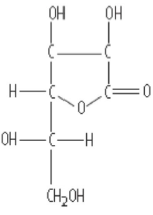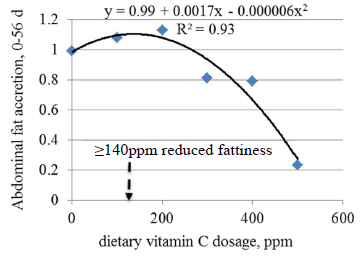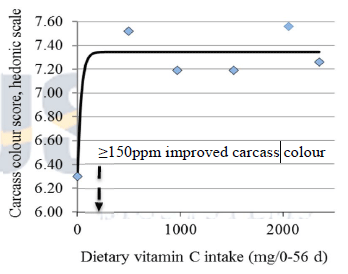Dietary Vitamin C recommendation for feed safety and performance of poultry
Published: May 20, 2014
By: Dr. David O. Akinde(Fusion Biosystems Europe)
Key points
- Vitamin C is critical to antioxidative nutrition
- Vitamin C efficacy is beyond anti-stress but also impacts fcr, weight gain, egg yield and adiposity
- Vitamin C is beneficial to detoxification and potentiates medication/vaccinal efficacy
- 300ppm (net) supplemental vitamin C promotes growth in broilers under tropical conditions
- Feed millers and integrators need to monitor the level and availability of vitamin C in feeds/premixes, especially as objetionable growth promoters are removed from the production system
Figure 1. A form of vitamin C (L-Ascorbic acid)

Vitamin C (VC) otherwise called ascorbic acid is a notable endo and exogenous antioxidant nutrient. Being one of the strongest among body anti-oxidant defense systems, VC neutralizes both intra and extracellular reactive oxidative radicals (RORs). Although RORs are metabolic byproducts (e.g. from enzymes and phargocytotic activities e.t.c), they must be expelled as they are toxic to body genetic materials, proteins and fats.
Anti-oxidative defense is pretty fitting to VC, because it is a versatile redox agent, able to donate and receive electrons. In fact VC is densely loaded in phagocytes and other immune cell as a sheltering mechanism from oxygen radicals, generated during pathogen elimination. But VC is not alone in these cellular defenses, it synergizes with other metabolites like vitamin E (VE), ß-carotene and the metallopeptides: glutathione and catalase. However it is the most important anti-oxidant in the extra-cellular fluids, rescuing lipid cellular membranes from RORs.
Other functions of VC are the induction of antibodies (immunity) and interferons to fight off viruses. For these multiple reasons body VC anabolism is unable to match metabolic demands during disease/stress (Cheng et al., 1990). The biosynthesis of collagen, the protein used in forming connective tissues like skin, gut walls, blood vessels, and even bones and cartilages requires VC. Super dosing VC promotes bone and egg shell mineralization (Orban et al., 1993) and the absorption of iron, so that we can conclude that this vitamin promotes gut health and efficient nutrient utilization.
Vitamin C in the development of robust response to stress/health challenges
The first animal performance is health! Unfortunately genetic selection for high yielding birds has resulted in birds short on immune/health robustness. At any rate stress/diseases are inescapable realities in practical poultry. Given that VC interferes in health and nutrition physiology, what benefits could it offer in a low drug application production systems?
1. Vitamin C benefits feed safety by stopping toxins and contaminants
Well VC improves feed-food safety by neutralising feed toxins! Toxins and contaminants (pesticides, heavy metals, mycotoxins and endotoxins) are ubiquitous concerns at the root of many morbidities and mortalities. Vitamin C mitigation of intoxications is multi-leveled and widely supported. A peritoneal injection of VC or VC + vitamin A recovered key anti-oxidant systems and prevented renal damage in rats challenged with endotoxin (Kanter et al., 2005). Benabdeljelil and Jensen (1990) reported that 100 – 5000ppm VC protected egg albumen quality from 10ppm vanadium contamination in laying hen diets. The latter benefit arises from therapeutic chelation of transition metals by VC. Haazele et al. (1993) showed that 300ppm of VC alleviated Ochratoxin A toxicosis in hens. But some studies have not been positive. For example Hoehler and Marquardt (1996) found no benefits of dietary VC in T2 and Ochratoxin A intoxicated cockerels. This could be because some conditions require the fusing of VC to other antioxidants. Indeed VC spares VE by recycling depleted VE (tocopheryl radicals) back to its reduced and bioavailable form. Also VC will defend against glutathione depletion.
2. Potentiating vaccination and medication
Dietary VC boosts medication effectiveness under immune compromisd conditions. This effiacy is crucial as management stressors typically weaken and disable the immune system from supporting optimal drug/vaccinal efficacy. Amakye-Anim et al. (2000) documented that 1000ppm of VC is beneficial to the efficacy of infectious bursal disease vaccination. Tuekam et al. (1994) reported that 500ppm dietary VC spec boosted infectious bronchitis antibody production in vaccinated birds. On the other hand 330 - 440ppm dietary VC have shown therapeutic efficacy against infectious bronchitis and against E. coli attack (Gross et al., 1988; Davelaar and Bos, 1992). All these dietary VC benefits can be linked to chemotactic influence of VC on the proliferation and functional integrity of lymphoid tissues, plus antioxidative defenses (McDowell, 2000).
3. Efficacy against heat stress and hypothermia
Widely supported is VC efficacy against hyperthermia. A mode of action is that this vitamin blocks adrenal glucocorticoids. This benefit is easily understood given that glucocoricoids production (as a result of stress) has catabolic consequences. Heat stress is a significant deleterious issue in tropical/subtropical regions, where most future growth in poultry is projected. In these zones vast numbers of birds are ‘normally’ exposed to heat; thus the need to compensate with optimum dietary VC level (Khan et al., 2012).
4. Performance promotion under field conditions
At Fusion research laboratory (Fusion Biosystems internal data) we reassessed a VC titration study with broilers exposed to tropical conditions (detailed by Ogunwole et al., 2013). We intended to advise VC dietary allowances based on the scope of responses (BW gain, fcr, abdominal fat (AFA), breast meat yield (BMY) and meat colour score (MCS)) to incremental intake of VC (as L-Ascorbic acid, coated). The first observation was that VC intake limited BW gain, AFA, BMY and MCS responses (Ogunwole et al., 2013). That is, under such practical conditions broilers stand no chance to realize their genetic potential without receiving optimum dietary VC supply.
Secondly diminishing return to incremental dietary concentration or intake of VC intake was detected in the performance traits studied (Figures 2, 3, 4 and 5). Thirdly all the criteria, namely, BW gain, AFA, MCS and BMY (not shown) attained saturation except fcr. Finally mathematical models were fitted to the data to deduce VC optimum relative to the suite of criteria earlier stated (Figures 2, 3, 4 and 5). Our computations suggested 300ppm and 301ppm as dietary levels that will maximize BW gain and BMY, respectively. An intake of 729mg, translating to 150ppm of diet was similarly modeled as the optimum for MCS. The inability of fcr to opimise within the dose range (0 – 450 ppm, Figure 3) suggests low metabolic conversion of VC. The later speculation seems plausible given further analysis indicating that marginal efficiency of utilization of ingested VC for BW accretion was low and decreased at a constant rate with additional supplementation (data not shown).
We are particularly struck by trends in AFA (Figure 4), which suggest an inverse relationship between AFA and VC supplementation. This is attributable to VC involvement in carnitine metabolism, which is critical to β-oxidation of long chain fatty acids. We calculated that to improve adiposity especially visceral fat, corn-soya diets need a minimum of 140ppm supplemental VC. Although this study was done in the tropics, it has implications for white meat quality worldwide. Indeed adiposity remains a problem to meat processors and consumers at large. It seem VC could be part of solution to this menace, unfortunately low to zero VC premixes pervade the global feed landscape, especially in the northern hemisphere. Thus we recommend more studies on this topic.
It is concluded that VC is a dietary tool to proactively manage stress/diseases, feed safety and bird performance. Thus feed millers and integrators make a mistake when they ignore this nutrient during feed formulation, opting instead for water application during stress spells. They do need to monitor the VC level in their feeds/premixes relative to their production targets, as well as the chemical potency of their supplements, as VC is the most unstable vitamin. Doing these needfuls are important particularly as we see the winding down of antibiotics and other objectionable stimulants in the feed-food chain.
Figure 2. Response in BW gain of broilers fed varying dietary vitamin C levels

Figure 3. Feed conversion in broilers fed varying dietary levels of vitamin C

Figure 4. Abdominal fat accretion in 56 d broilers depending on dietary vitamin C dosage

Figure 5. Variations in Meat colour score broiler depending on dietary vitamin C dosage in 56 d

Related topics
Authors:
Fusion Biosystems
Recommend
Comment
Share
6 de mayo de 2016
dear Dr.muhammad Zahid Farooq
of course you can add vit.C daily in drinking water of the broiler chickens reared under hot condition
Recommend
Reply
6 de mayo de 2016
we did before 5 years research about the Effects of supplemental ascorbic acid on humeral immune response in broilers reared under heat-stress condition ..
https://www.researchgate.net/publication/269709166_Effects_of_supplemental_ascorbic_acid_on_humeral_immune_response_in_broilers_reared_under_heat-stress_condition
Recommend
Reply
Recommend
Reply
Recommend
Reply

Would you like to discuss another topic? Create a new post to engage with experts in the community.











.jpg&w=3840&q=75)